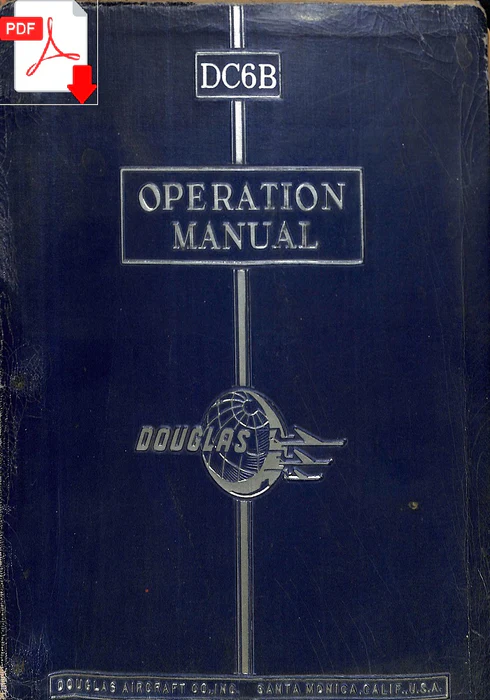
Douglas DC-6A and DC-6B Description and Operation Manual (ebook)
Douglas DC-6A and DC-6B Description and Operation Manual
1955
The DC-6A and DC-6B series airplanes, built by Douglas Aircraft Co., Inc., are long-range, low-wing monoplanes with full cantilever wing and empennage, semi-monocoque fuselage, and fully retractable, hydraulically-actuated, tricycle landing gear. The airplanes are powered by four Pratt & Whitney Double Wasp, 18-cylinder, 2800-cubic-inch displacement, radial engines equipped with Hamilton Standard reversible-pitch propellers.
Its maximum speed is 508 km/h, and it can transport between 54 and up to 102 passengers on up to 4,800 km.
704 aircraft were built between 1946 and 1959.
The main cabin, the cockpit and flight compartment, and the lower fuselage compartments are pressurized and heated by an air conditioning system that can be operated either automatically or manually. The windshield and the leading edges of the airfoil are protected against ice accretion by heated air.
Crew accommodations consist of two upholstered, adjustable seats for the captain and first officer. A jump seat, installed just aft of the control pedestal and over the step, is for the use of a flight engineer and folds up and stows against the inboard face of the radio rack. Optional installations can be made for a radio operator and a navigator.
The DC-6A airplane is designed for cargo transportation and is equipped with cargo tie-down fittings, cargo doors, and other cargo handling equipment. The DC-6B airplane is designed for passenger transportation and is equipped with suitable interior furnishings and equipment.
The DC-6A and DC-6B Description and Operation Manual is divided into two primary sections: Section I, Airplane Operating Procedures, and Section II, Air-plane Systems and Equipment. An appendix, listing the effectivity of system and/or unit installation, and an alphabetical index are also included.
Section I incorporates instructions for operation of the airplane under both normal and emergency conditions. Each phase of operation is incorporated in a separate chapter, and each chapter is individually paginated and paragraphed.
Section II incorporates functional description of the airplane's airframe and operating systems. The components of each system are referred to and covered by function only in their associated systems; they are detailed in their respective systems.
633 pages – in English - PDF to download























